1lumen selects and reviews products personally. We may earn affiliate commissions through our links, which help support our testing.
RichFire LEP Flashlight Review

RichFire LEP (SFC-039) specifications
| Brand/model | RichFire LEP (SFC-039) |
|---|---|
| LEP | LEP |
| Lumens | N/A |
| Beam intensity | / 200-500m |
| Battery config. | 1*21700 |
| Material | Aluminum |
| Modes | 2 |
| Blinkies | Strobe, SOS |
| Lens | Aspheric |
| Waterproof | N/A |
| Review date | July 2021 |
Introduction:
To make a budget flashlight brand, you pick a 4 or 5 letter word, put “Fire” on the end and add 3 red flames above the last 2 letters. This is what RichFire has done, along with UltraFire, ThorFire, UranusFire, SingFire and countless others. On BudgetLightForum this is sometimes taken as a literal joke: that the flashlights are of such poor construction that they’re likely to cause an actual fire. In reality, as long as you don’t leave them unattended then it’s difficult for a flashlight to unintentionally start a fire.
So when I was asked to review the “RichFire LEP”, I was intrigued: could a very budget brand create something with this new LEP technology? When I looked at the product listing that said it was up to 500m throw I wasn’t even 100% sure it was a LEP. (It actually throws well over 500m.)
Actually, some of these budget “Fire” brands are pretty good. For example, SingFire were behind the SF-348 penlight, which got a special BLF version with Nichia 219B, though the brand no longer exists.
I hadn’t heard of RichFire before: with a bit of Googling I found that the company behind them is Shenzhen SingPad Technology Company. A bit more digging and I realised that that’s the same company behind the SingFire brand and that the official model name of this LEP is SFC-039. It seems like SingFire lives on as RichFire.
I can confirm that this is a LEP: not just a LED flashlight that’s been listed wrongly or badly translated. It’s also definitely a budget LEP. I’ve seen the discounted price drop below $90, which is cheaper than any other LEP flashlight currently available in 2021.
Package quality.
OK, this is definitely a budget flashlight. The flashlight was shipped in a padded envelope and thin cardboard box with a bubble wrap bag. I’m surprised that the light managed to travel halfway around the world and still got to me in 1 piece, albeit with a dented box. Some $15 Convoy lights come in similar packaging, though the box always seems to arrive in better condition.
In the box you get:
- RichFire LEP flashlight
- Lanyard
- USB-C cable
- Cell adaptor
The cell adaptor fits over a smaller 18650 cell and allows you to use it like a larger 21700 cell.
There’s no manual, warranty card, or other information. In fact, the only information I could glean from the package was that it was made in China.
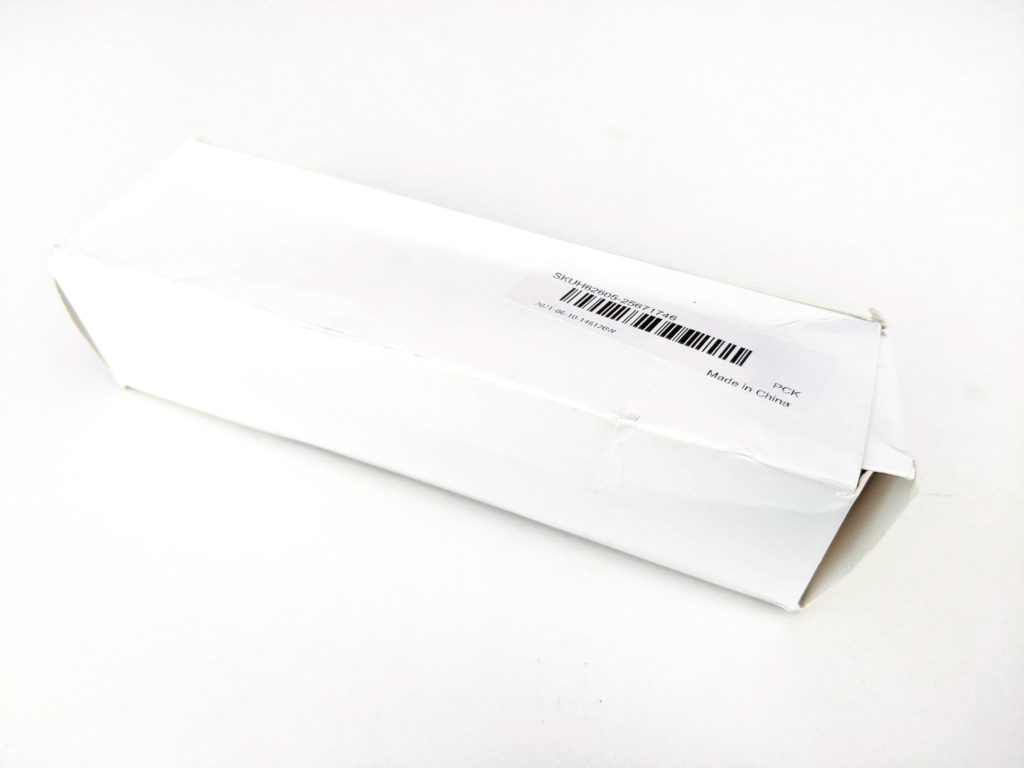
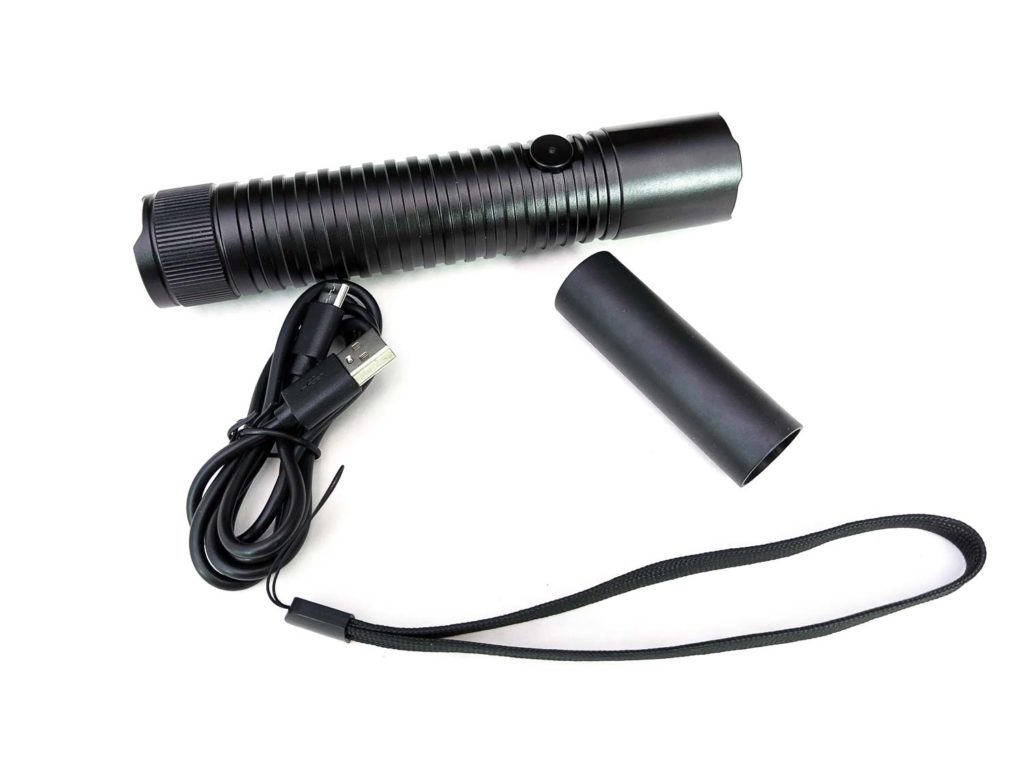
Flashlight in use
I don’t know if it was just my expectation from the packaging but when I picked up the RichFire LEP I could tell it was on the budget end of the quality scale. On further inspection it’s not actually bad – in fact it’s certainly higher quality than a couple of cheap zoomies I have.
The size and shape are a bit like a Convoy S11. I have smaller straight tube lights and bigger lights with large heads but no other large straight-tube lights. The LEP should very easily fit in a jacket pocket but with a body diameter over 30mm I’d struggle to carry it in a trouser pocket.
The switch is a side e-switch, which I prefer to tail switches. Side switches are harder to find but once your thumb is on them I find them easier to carry at waist height than tail switch lights. Fortunately, the RichFire’s side switch protrudes about 3mm to make it easy to find without looking. That comes at the cost of accidental pocket activation though, as there’s no electronic or physical lock out. The switch is solid and needs a good press to activate it.
The side switch is the only thing that stops it rolling too. It can tail stand fine, though with a single hole for the string it will be wobbly with the lanyard attached.
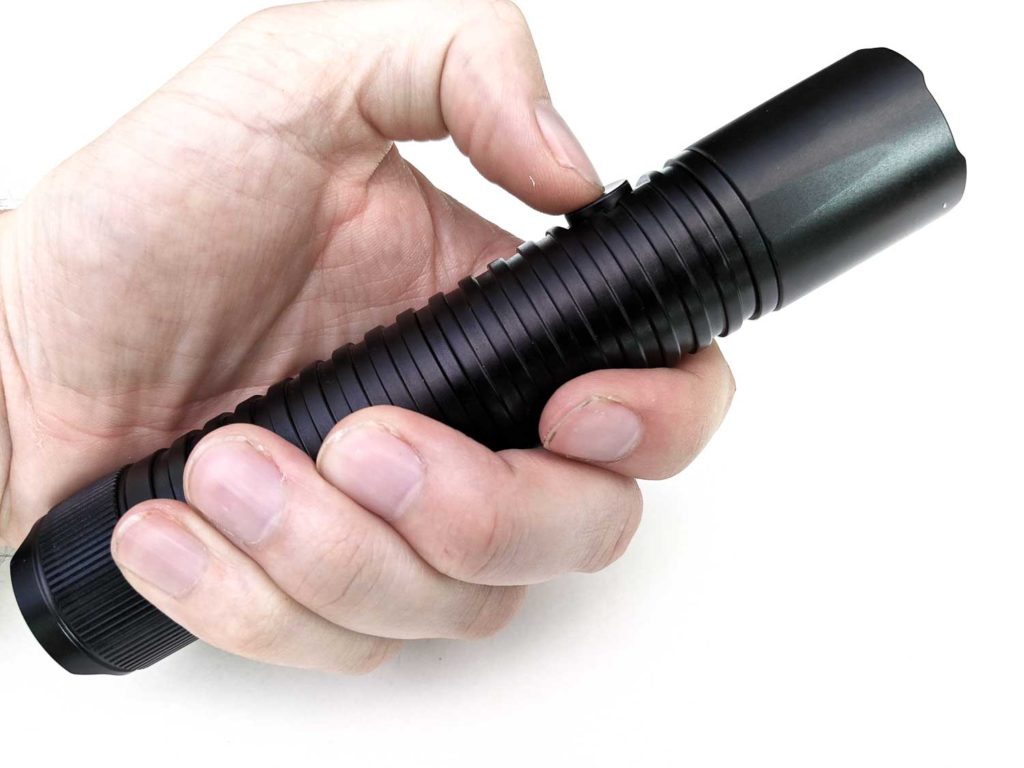
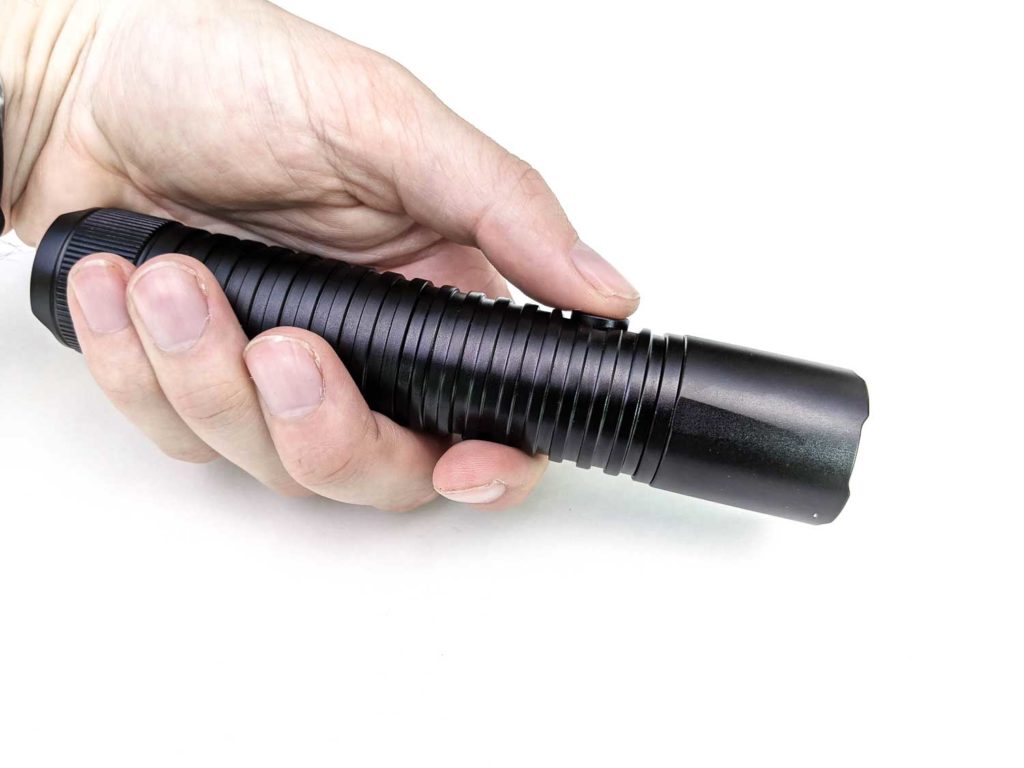
Build Quality, and Warranty
It has shiny and slippery anodisation on the aluminum, which seems reasonably well done. There’s wide annular (ring) knurling on the body for grip and linear knurling on the tail cap to make it easy to unscrew.
When unscrewing the tail cap, first you see that there is an o-ring in place, with a bit of lube. A couple more twists of the cap and you’ll see that the threads aren’t anodized. They’re square cut but a massive 2.8mm pitch from 1 to the next. Although unanodised, the threads do seem well machined. However, the lack of anodisation does mean that you can’t unscrew the tail cap to disconnect the circuit from the cell. I’d recommend either keeping a cell in a separate container or using an insulator if transporting the light, to ensure it doesn’t turn on accidentally.
The tailcap spring is substantial enough but quite long. The body tube also unscrews from the head. Again, these threads are not anodised but this time they’re triangular cut.
The driver side of the head has a spring too but this one is tiny. This is the kind of spring I’d expect on an AAA flashlight.
With O-rings in all the right places and a rubber cover over the charging port, this should be waterproof. It hasn’t been tested, so I wouldn’t recommend submerging it on purpose.
The lanyard is very standard and does the job well.
There’s no warranty information in the package or on product listings but digging around their other flashlights say “One year warranty for flashlights” and “We will replace a new product within 15 days of purchase for any manufacturing defects.” RichFire also provides free repair outside of warranty, only charging for parts.
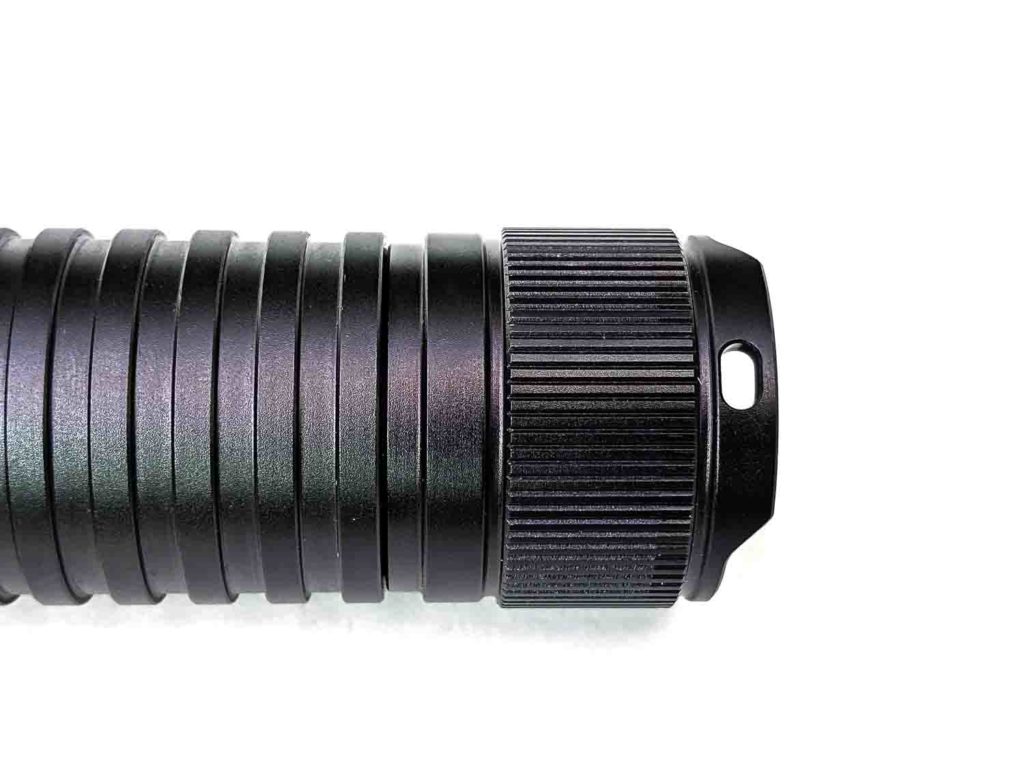
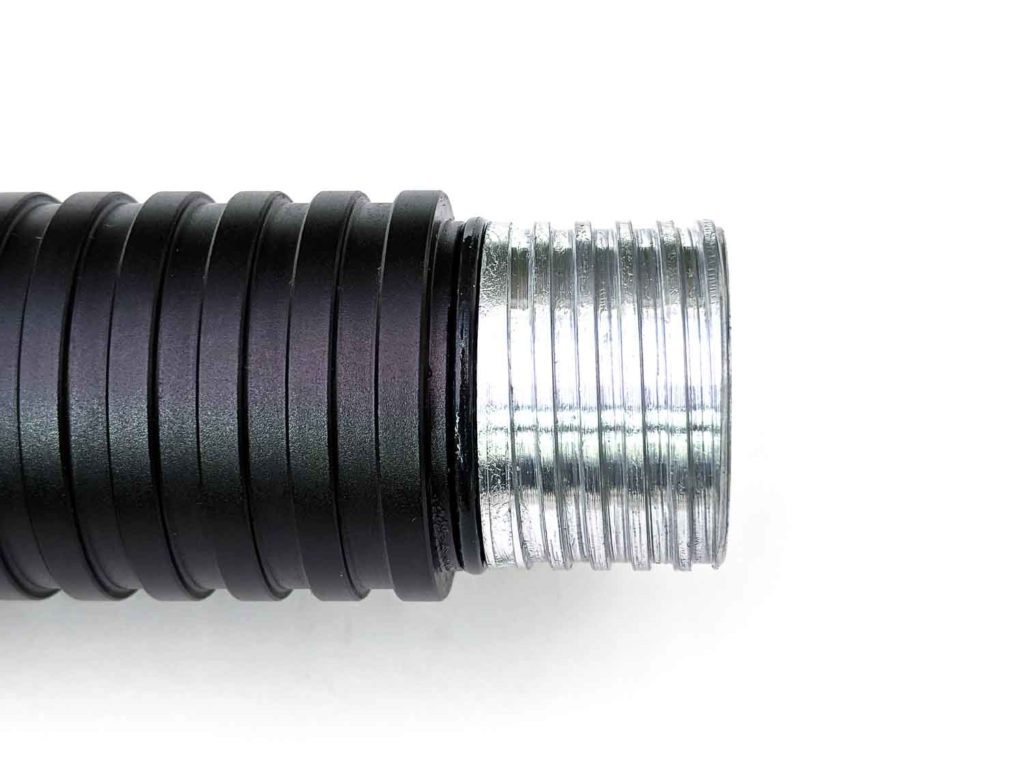
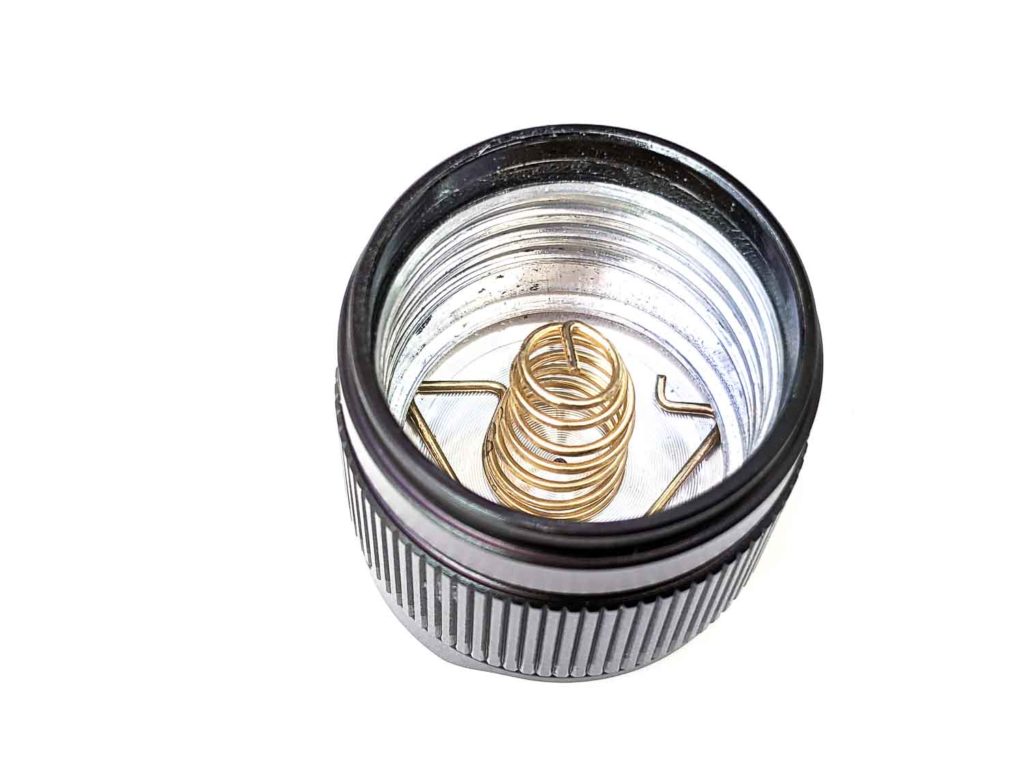
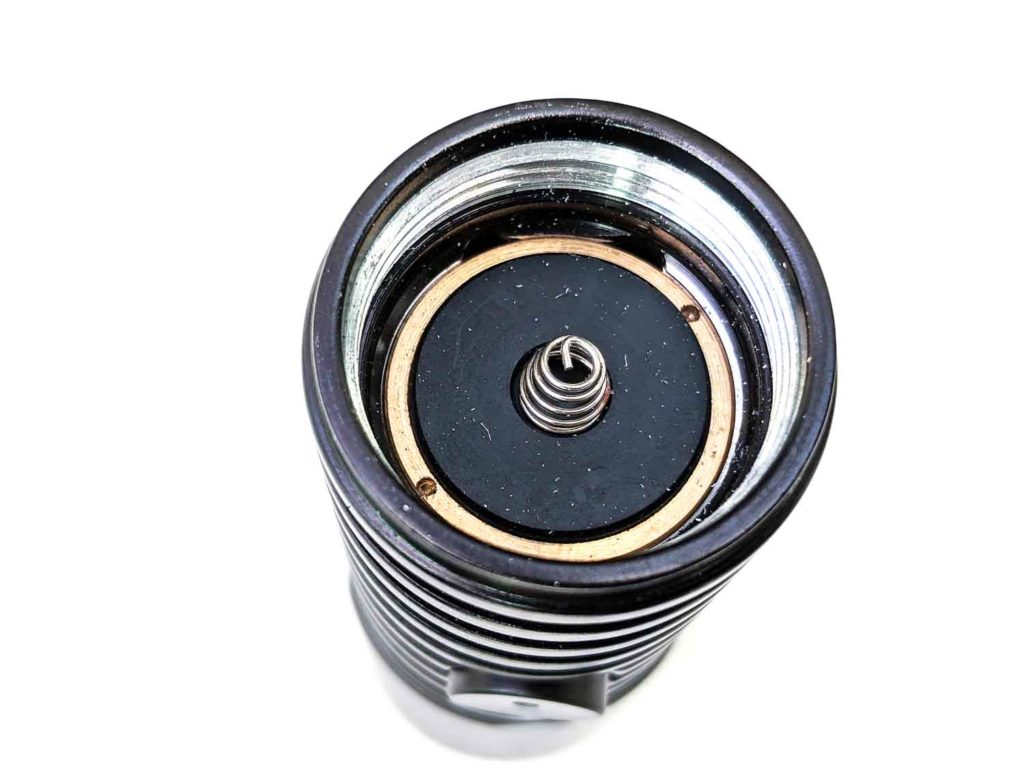
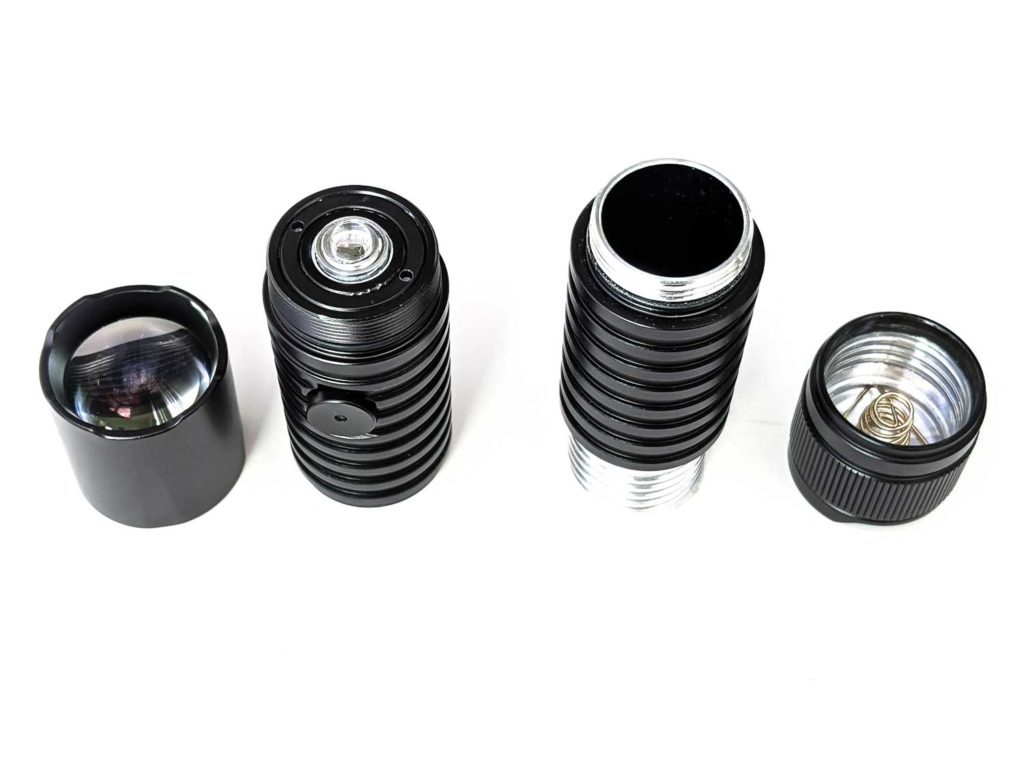
LED, Lens, Bezel, and Reflector
The head unscrews easily into 2 parts. The crenelated bezel is all 1 piece, with an aspheric glass lens.
The main part of the head contains the driver and LEP module. Yes, it’s definitely a LEP – Laser Excited Flashlight. This one is shine-through style, where the laser shines up through the phosphor (like the Maxtoch L3K), instead of using mirrors (like the Lumintop Thor II). At the top of the LEP module you can see a small hemisphere lens and under it a small dot of yellow phosphor. The phosphor is lit up by a blue laser, producing white light.
Without the aspheric lens, the LEP produces a fairly wide and even beam around 60°. The beam is yellow, with lots of chromatic aberration from the small lens. Screwing the aspheric lens back on, the beam starts to focus and has a very blue ring. This is worse than any “CREE rainbow” that I’ve seen. You could use the flashlight with the head slightly unscrewed if you needed light over a wider area but it’s clearly not designed to zoom.
Fortunately, when fully focused the blue goes away, resulting in an intense yellowy white spot. There’s also a noticeable halo, though this isn’t too bad outdoors at night.
I was expecting the worst from the beam but it’s actually fairly reasonable for what it is. If you’re buying a budget LEP then you’re probably not as concerned about the light quality.
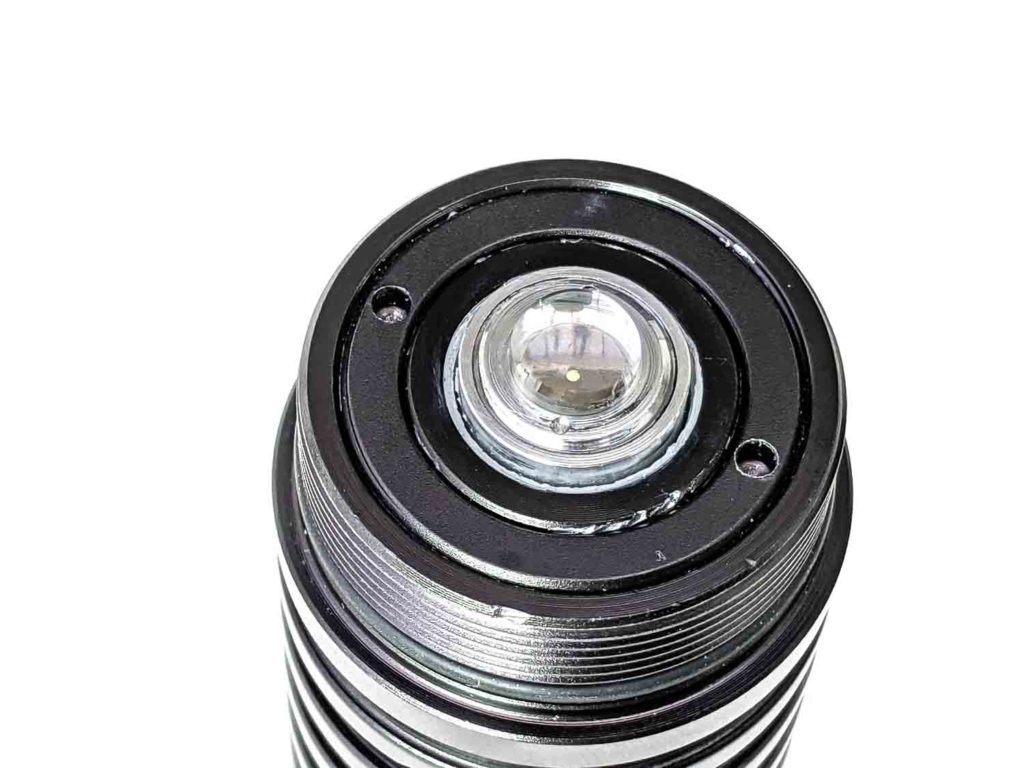
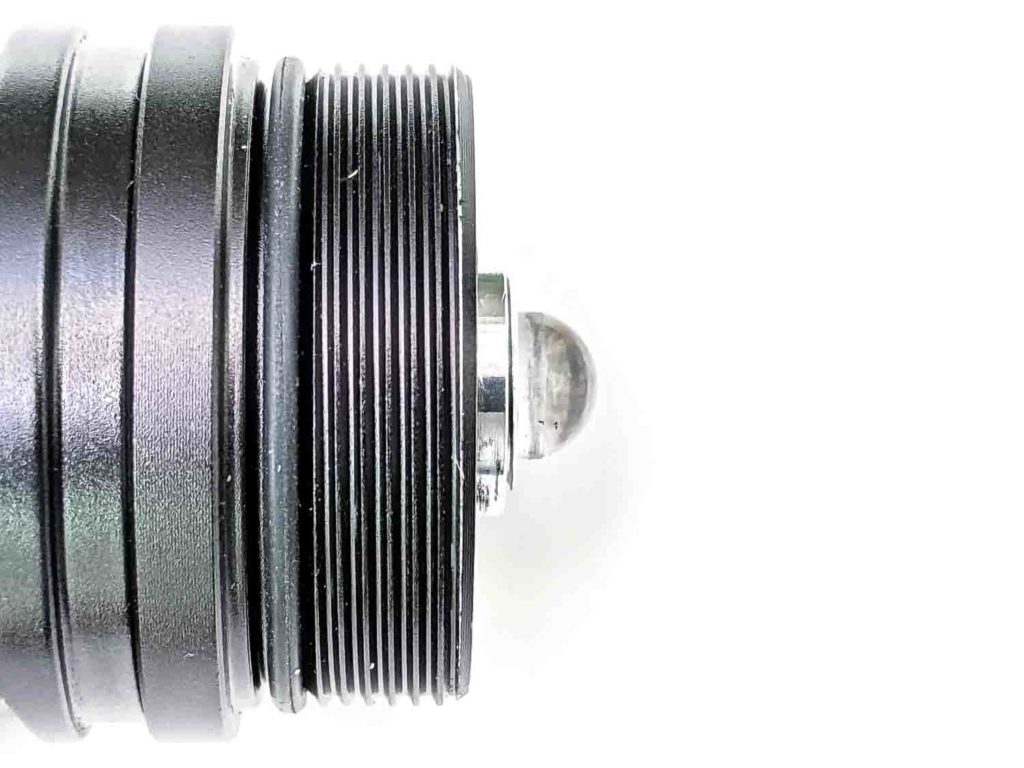
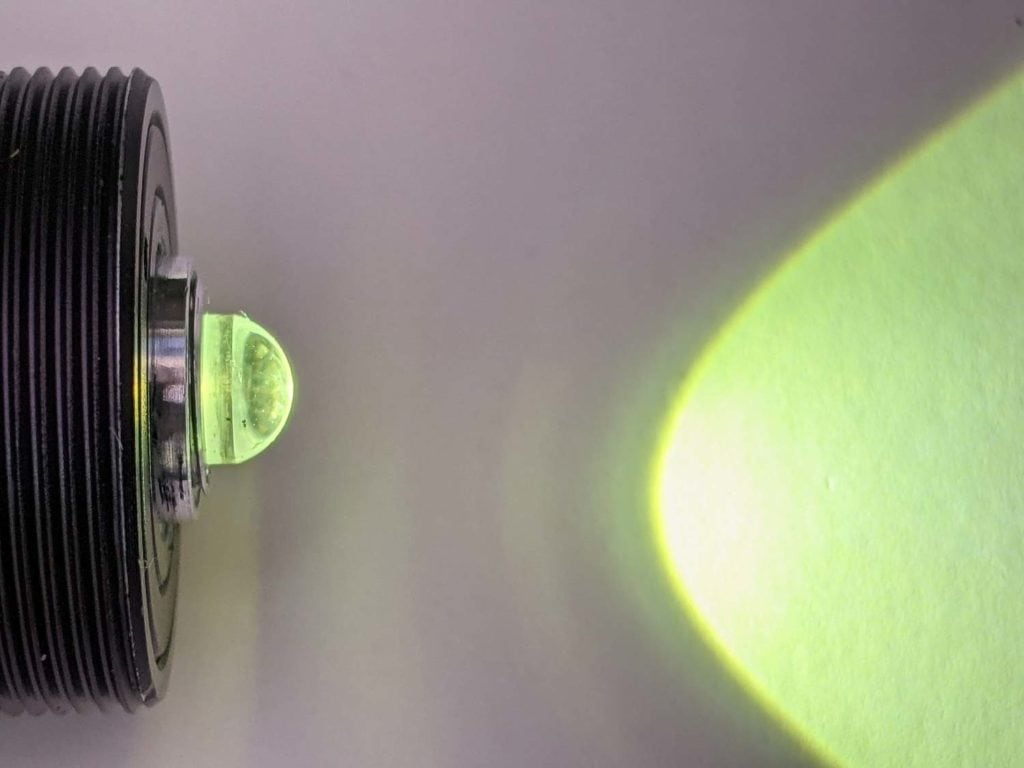
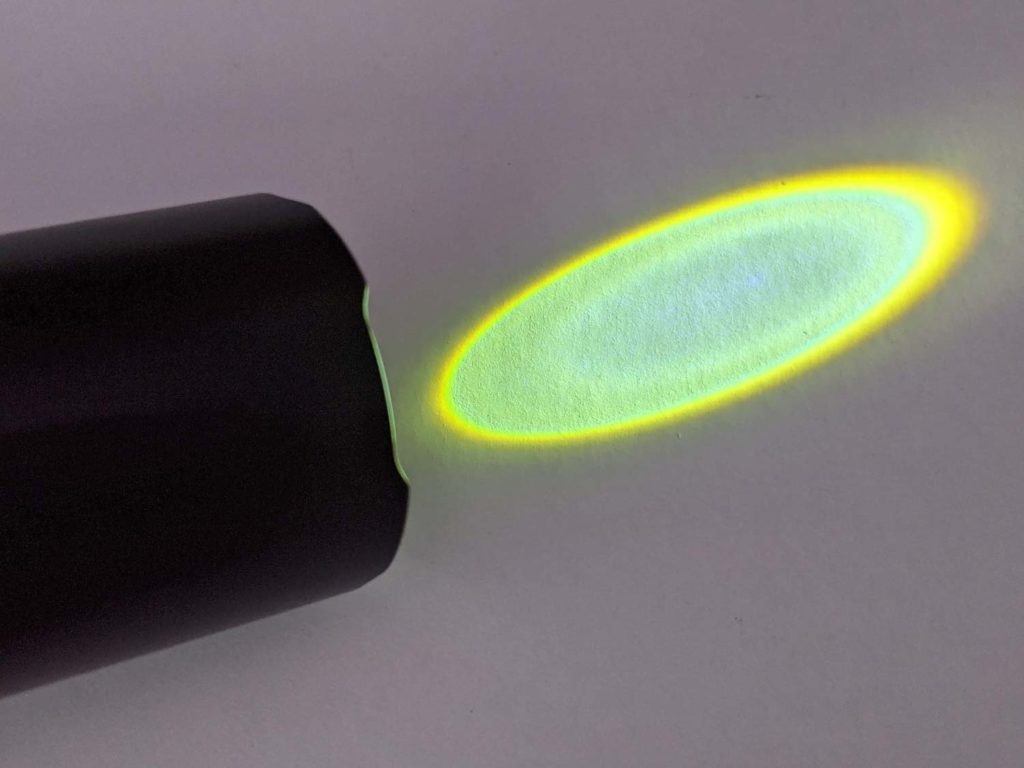
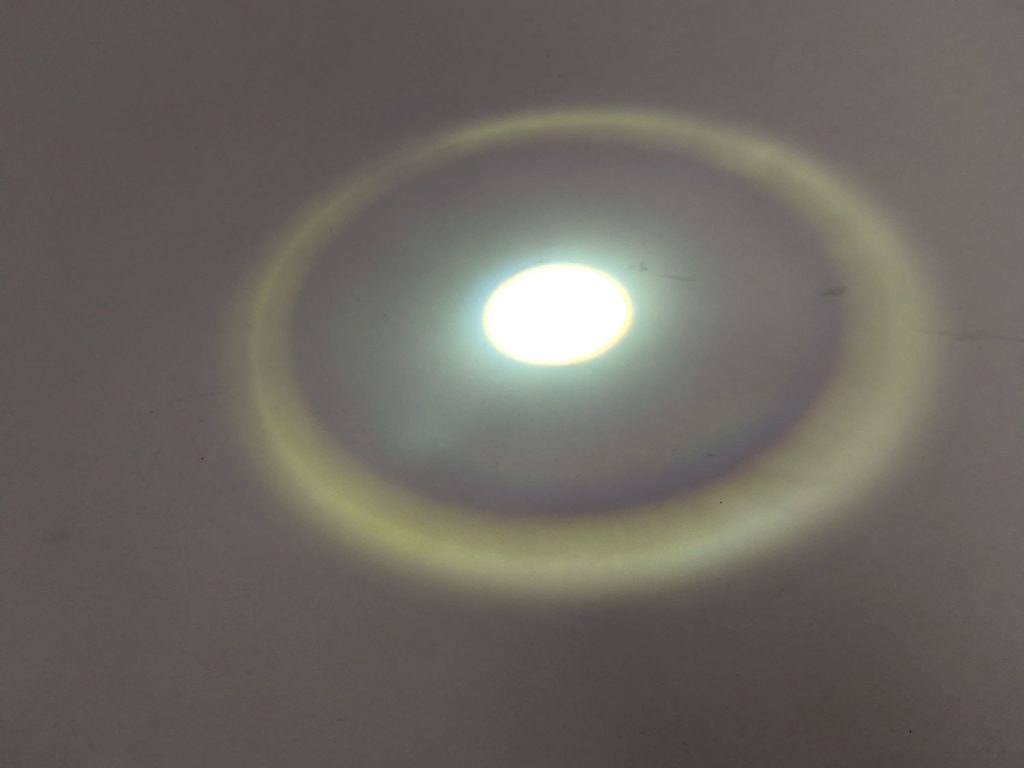
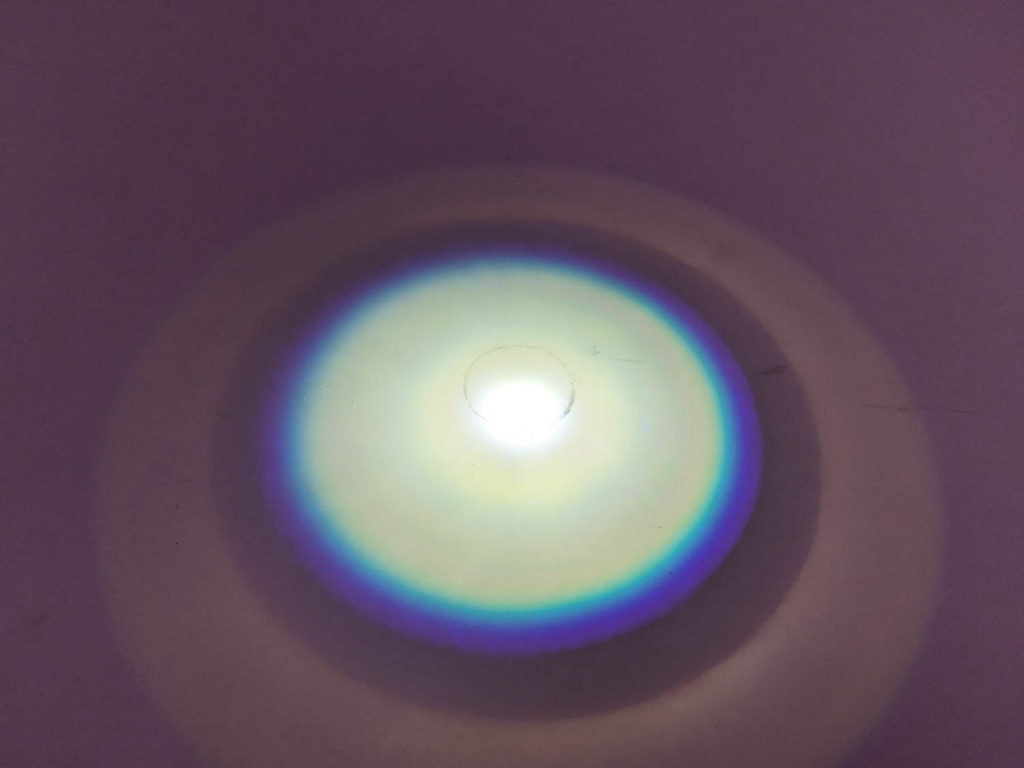
Dimensions and size comparison
- Length: 16.4 cm / 6.46 inches
- Head diameter: 3.20 cm / 1.26 inches
- Body diameter: 3.20 cm / 1.26 inches
Weight:
- With 21700 cell: 255g / 9oz
- Without cell: 180g / 6.3oz
Flashlight thrower comparison
Compared to other LEPs and small throwers, from left to right
- Convoy S21B
- RichFire LEP
- X800 zoomie clone
- Lumintop Thor II LEP
- Convoy Z1 (zoomie)
Compared to a larger thrower
- Astrolux EA02
- RichFire LEP
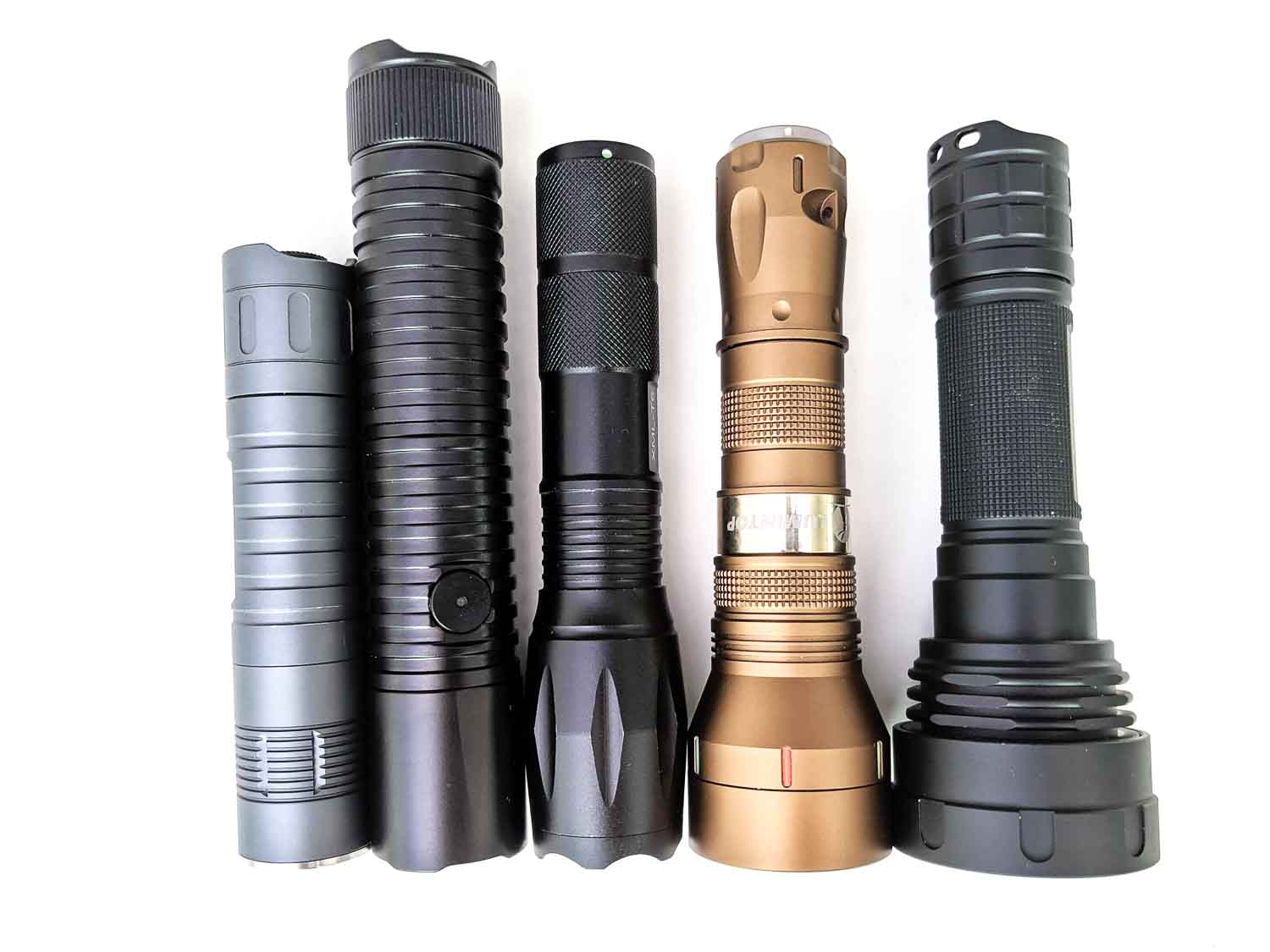
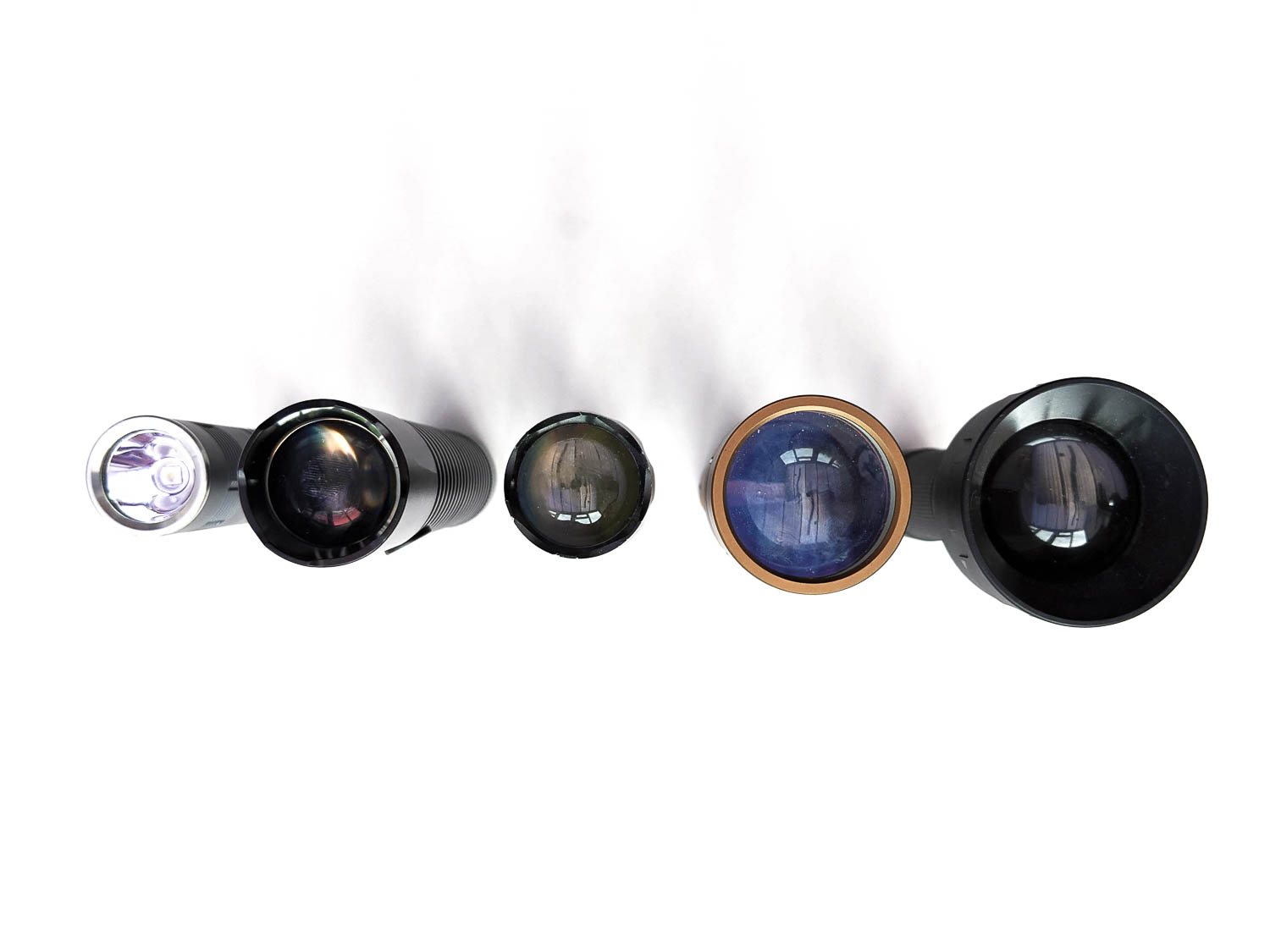
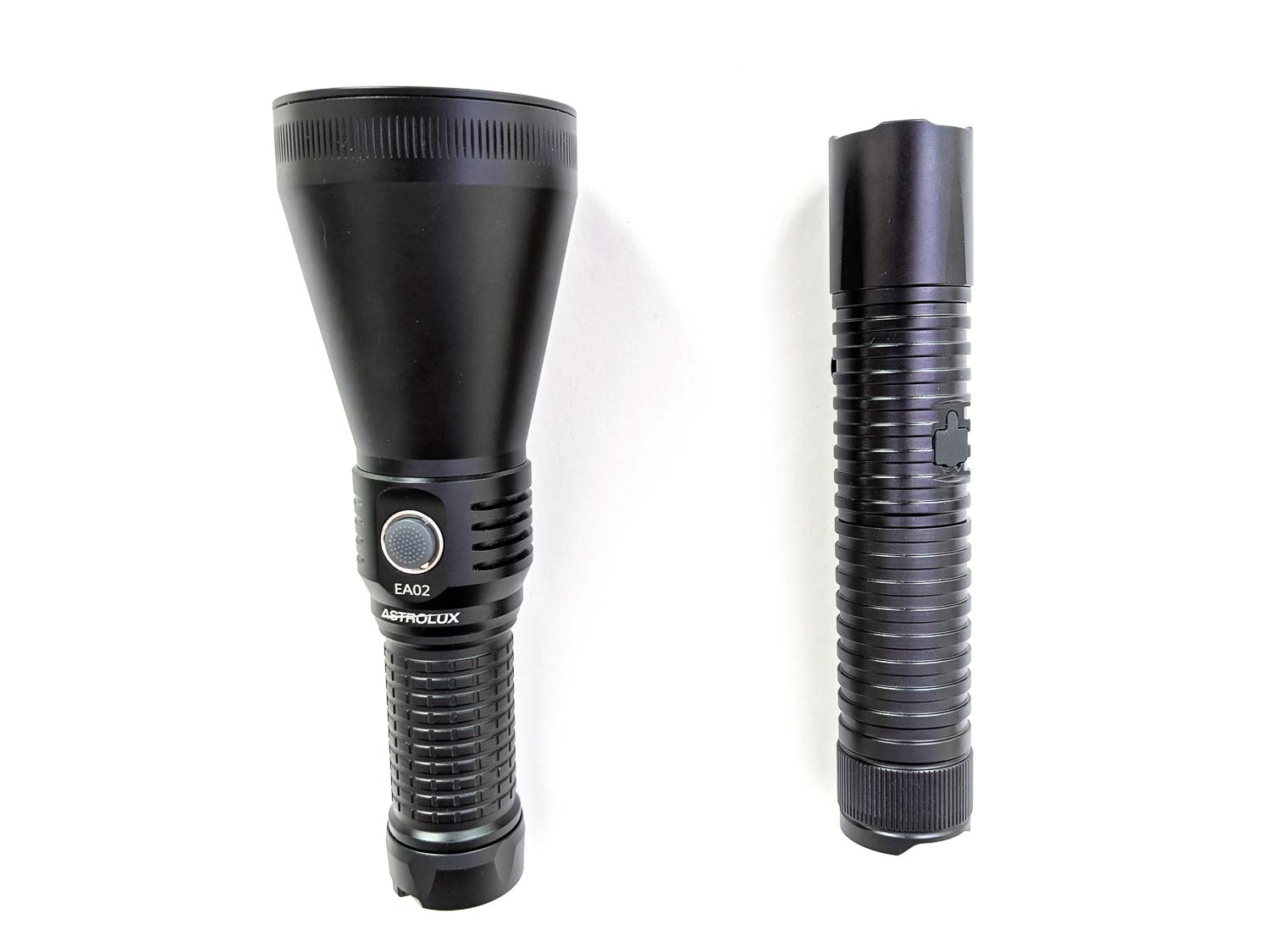
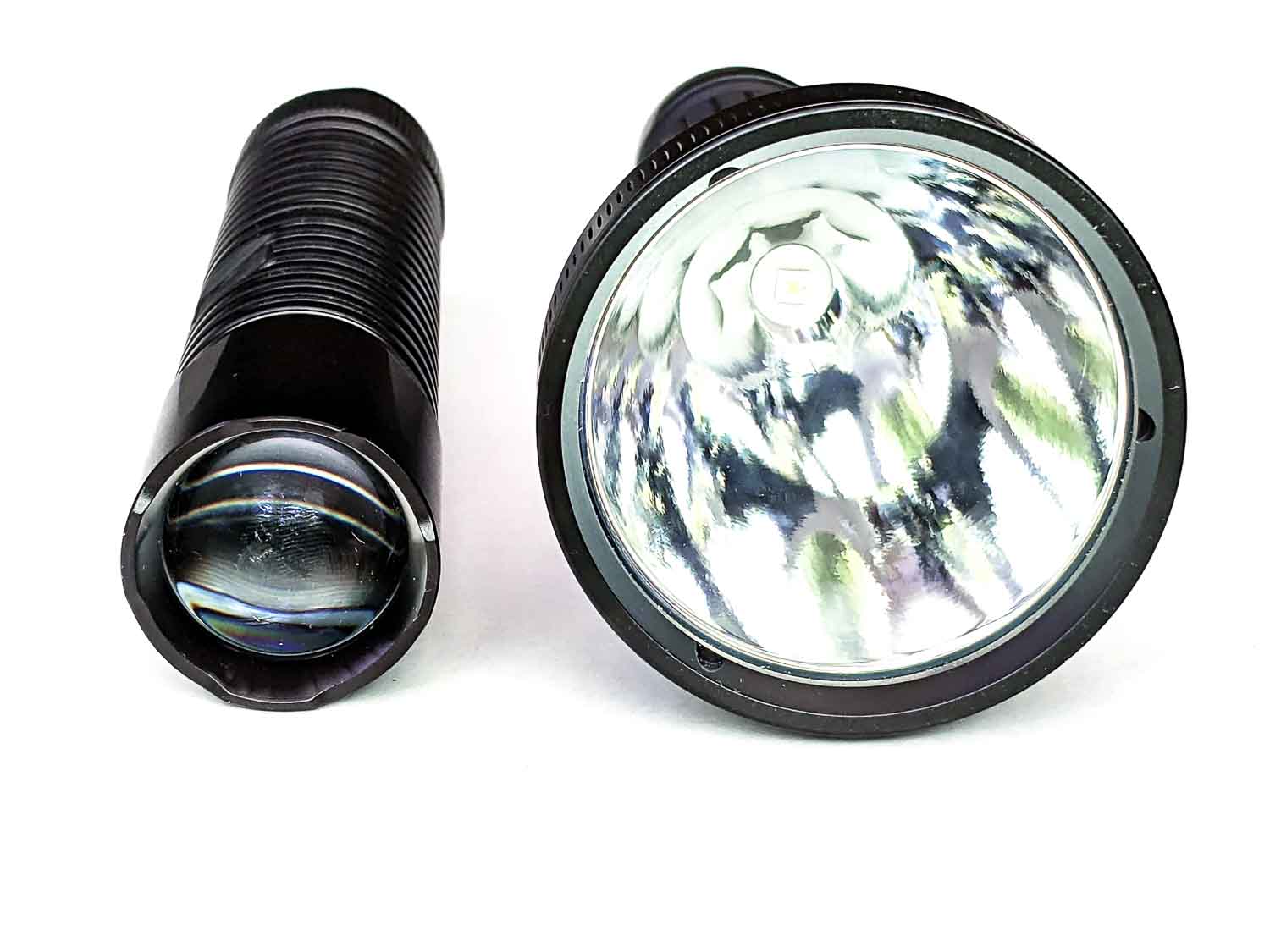
Driver & User Interface:
The LEP is controlled by the side e-switch with a simple UI: click to change modes and hold to turn off. Although there was no manual, from what I can tell there’s no secret shortcuts or double/triple click functionality.
The LEP always starts on high as there’s no mode memory. When clicking through modes, the light will cycle through Off after SOS, rather than going back to high.
When on with a charged cell, the e-switch indicator lights up green. Empty cells result in a red indicator light instead.
Modes: High, Low, Strobe, SOS, Off
From OFF:
- Click: high
From ON:
- Click: change modes: Low, Strobe, SOS, Off
- Hold: Off
Mode memory:
- No
Low voltage warning:
- Yes, the flashlight will drop to a low mode, then start flickering and the indicator light will go red
Strobe/blinkies
- Strobe and SOS are in the main mode group but you can turn the light off before you get to them
Lock-out mode:
- No
PWM
- I couldn’t see any by eye or with a camera
Batteries & Charging
The RightFire LEP doesn’t come with batteries but does include an adaptor for 18650 cells. Standard flat top 21700 cells work fine. A 75mm cell with charging port kind of turned the light on fine but doesn’t fit well enough to be able to screw the tail cap down properly. Button top 21700 cells should fit, as long as they aren’t too long.
The 18650-to-21700 adapter is plastic with a metal post in the top. This allows flat or button top 18650 cells to work with the light.
The flashlight also includes a USB-C charging port under a rubber cover. When charging a cell the indicator light goes red and it draws up to 1.45A, reducing as the cell voltage increases. This is pretty good and should charge a 5000mAh cell in 3-4 hours. You’ll need a standard USB A to C cable for this, as C to C doesn’t work. The charging circuit stops at 4.18V.
You can power the LEP via USB too, with it drawing up to 1.7A on high.
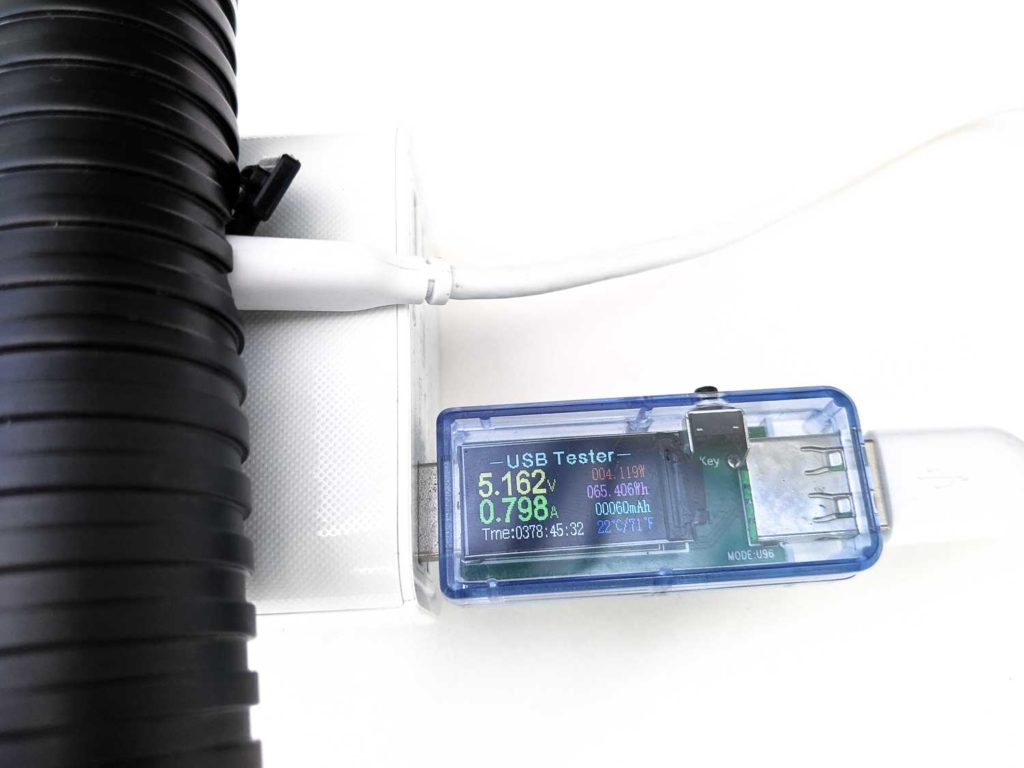
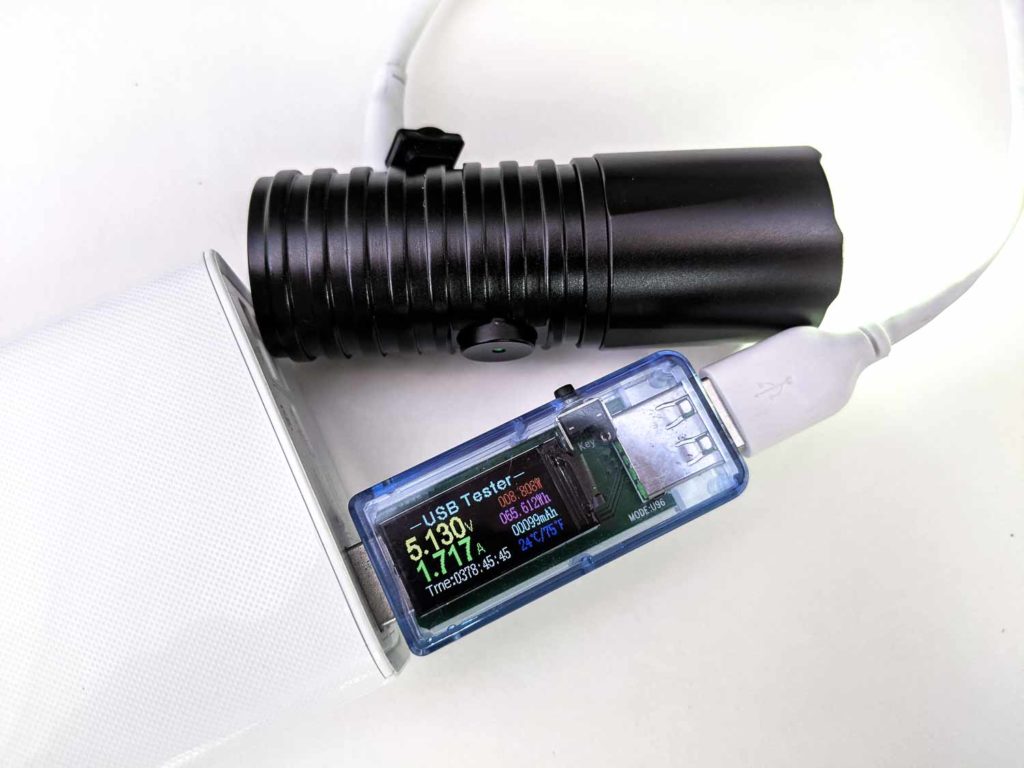
Performance
Lux meter: All lux and lumen measurements are from my home made integrating sphere, calibrated with a S2+ measured by Maukka. Measurements are done with a UNI-T UT383S lux meter and Adafruit TSL2591 connected to a Raspberry Pi (using RuTiTe by bmengineer). Expect them to be within +/-10%. I measured throw indoors at 10m.
DMM: Current readings were taken with a Precision Gold PG10B DMM for low currents and a Mustool X1 clamp meter for high currents, all with the cells fully charged via the built-in USB charging to 4.18V.
Parasitic drain:
- 0.036mA – nothing to worry about
Runtime graph
Runtime was done with a 5000mAh cell.
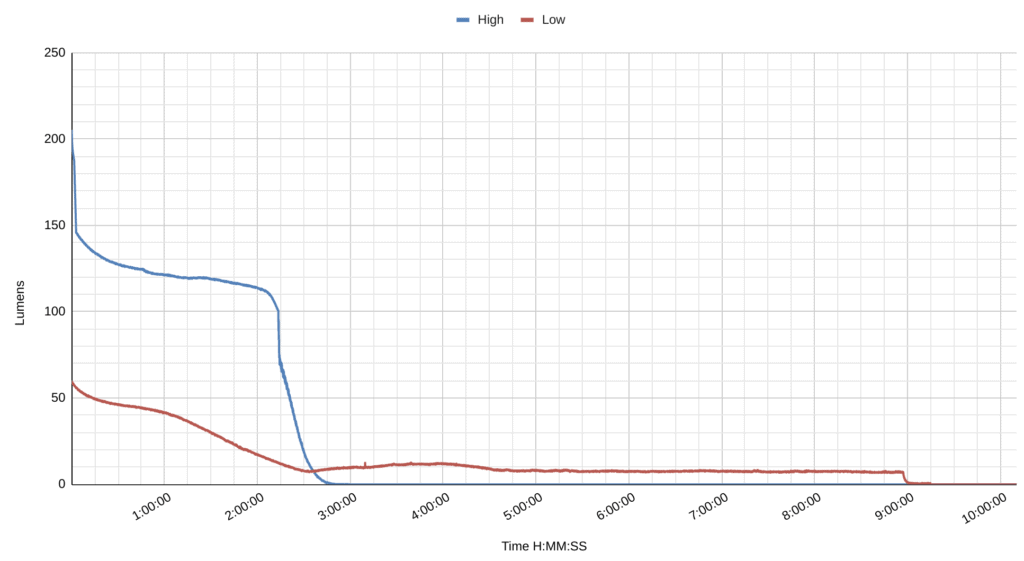
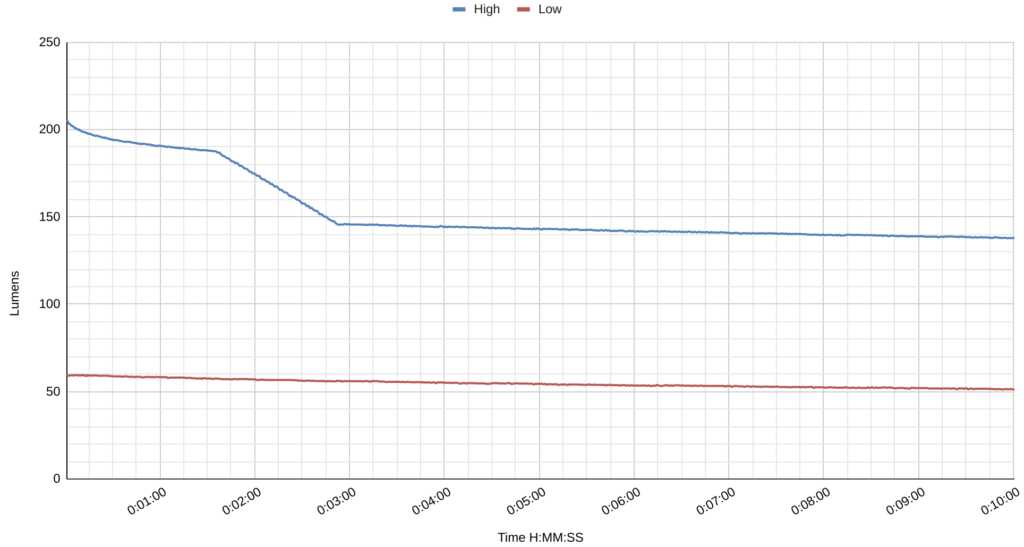
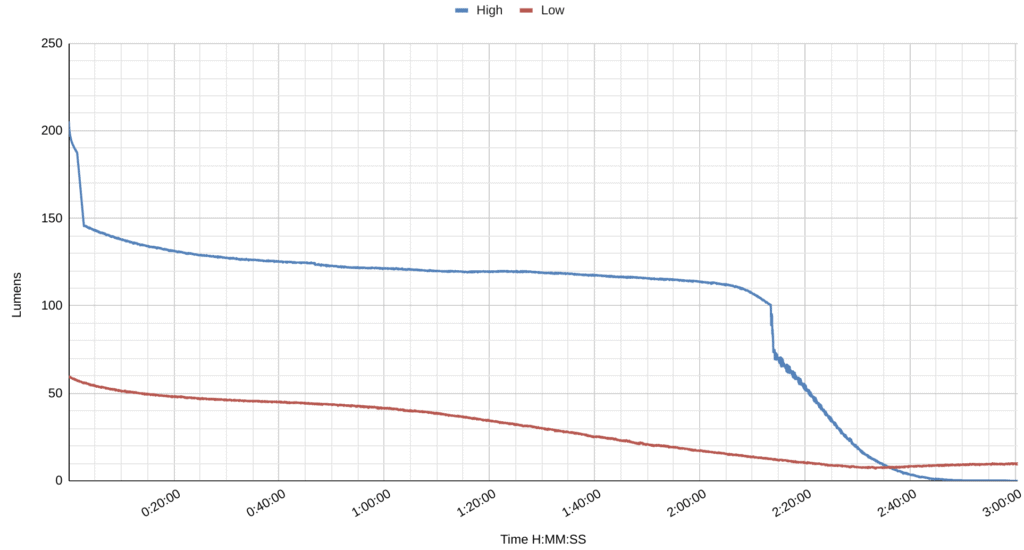
On high the light starts off at 200 lm, quickly dropping down to 150 lm over 3 minutes. The light then slowly decreases output, lasting over 2 hours at 100 lm. Around 2h15m it then starts dropping faster and finally turns off after about 2h30m, with the cell at 2.89V.
On low the light starts around 60 lm then gradually drops. After 2h30m it’s around 10 lm. It sustains this for about 6 hours more before going very dim and flickering. I left the light on overnight and by the morning it was 2.68V.
Lumen measurements (for each mode)
RichFire don’t specify the lumens (or candela) for this light, only “5W”. I was drawing almost 10W from the cell at 0s, so I’m not sure where this number comes from.
As a LEP, the lumens shouldn’t really matter, though it’s interesting to see the efficiency and run times. I used a Wurkkos branded 21700 cell for these. Higher drain cells (like the Samsung 30T) had no real difference in output.
| Mode | Amps | Specs | 10min | 30 sec | start |
| Low | 0.83A | – | 51 lm | 59 lm | 59 lm |
| High | 2.33A | – | 138 lm | 194 lm | 205 lm |
Throw numbers:
What you’ve been waiting for: does it thow? Yes! Fairly well anyway – at least better than LED lights the same size.
For some reason RichFire doesn’t specify the throw distance or candela for this light, which probably puts some people off buying it. When I first got this flashlight, I honestly didn’t know if it was going to be more like a cheap zoomie that throws under 300m or the Acebeam W10 II that throws 1217m.
At a hair under 200kcd it’s nowhere near the throw of higher quality small LEPs like the W10 but it still throws considerably more than LED flashlights the same size. In fact, to throw further you’ll need at least a 50mm bezel like the Manker U22 II or Acebeam L18. LED flashlights of the same bezel size won’t throw past about 500m. The original Weltool W3 LEP (non-pro version) throws about the same distance at 848m.
| Mode | Throw distance | Candela |
| Low | 448m | 50,111 cd |
| High | 890m | 197,896 cd |
Combining the throw with runtime numbers, the light maintains over 100kcd (632m) for 2 hours.
Beamshots
Distance to the building is 170m. Photos were taken with a Pixel 3a, set to 1/3s shutter speed and ISO 400, F1.8.
Beamshots:
- Astrolux EA02
- Astrolux MF04
- Astrolux WP2
- Convoy S21B
- Convoy Z1
- Lumintop Thor II
- RichFire LEP
- X800 zoomie clone
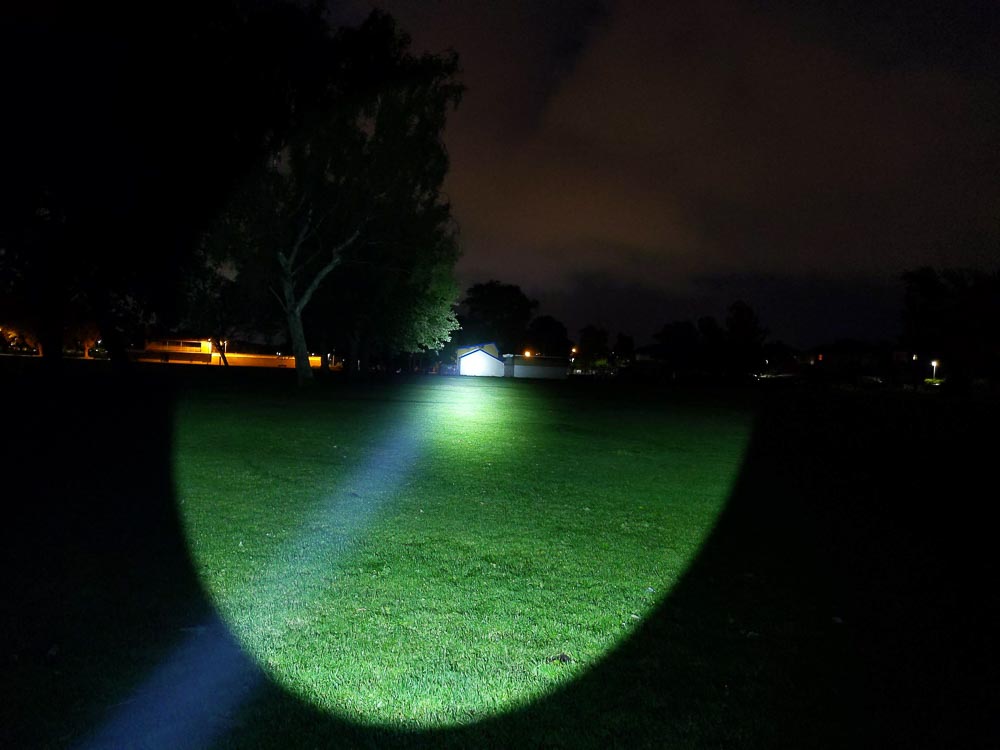
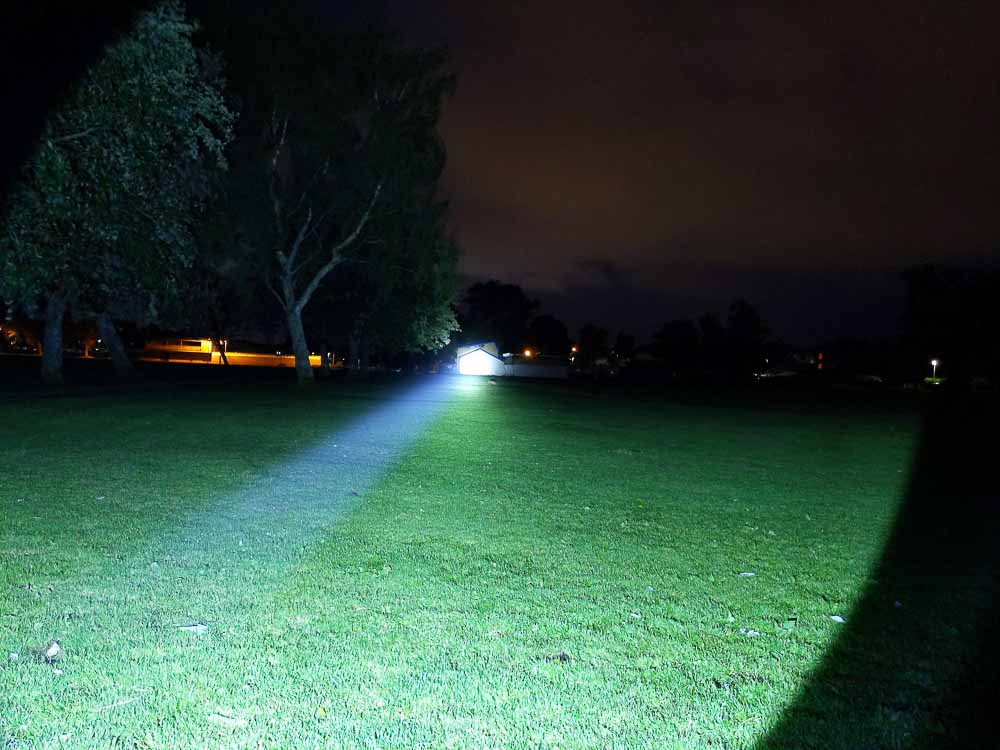
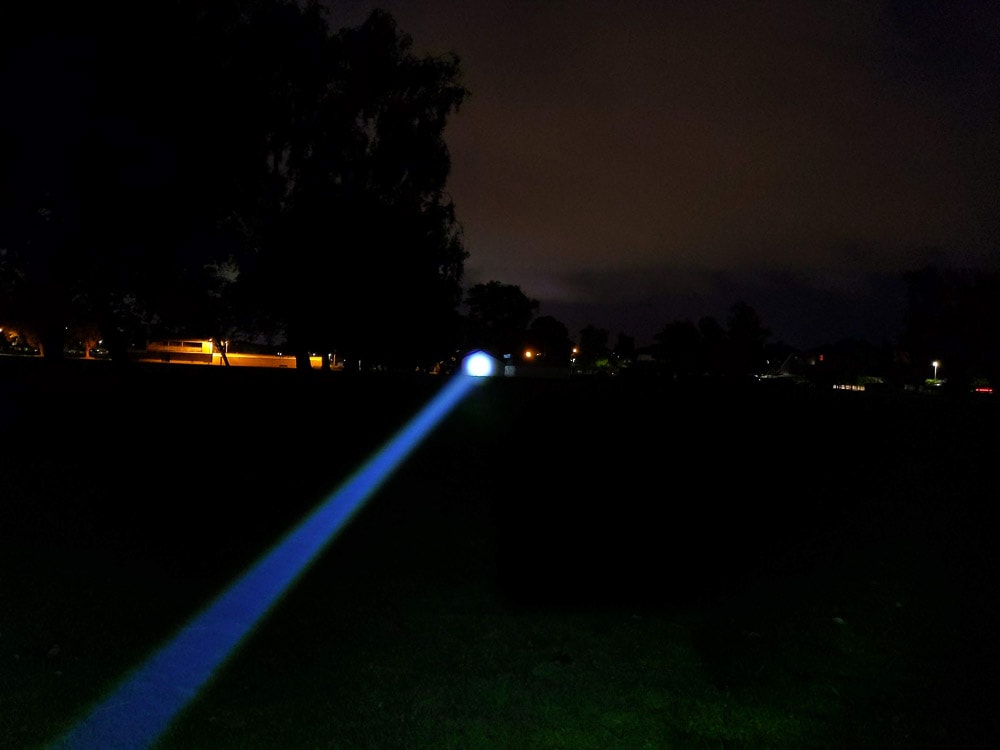
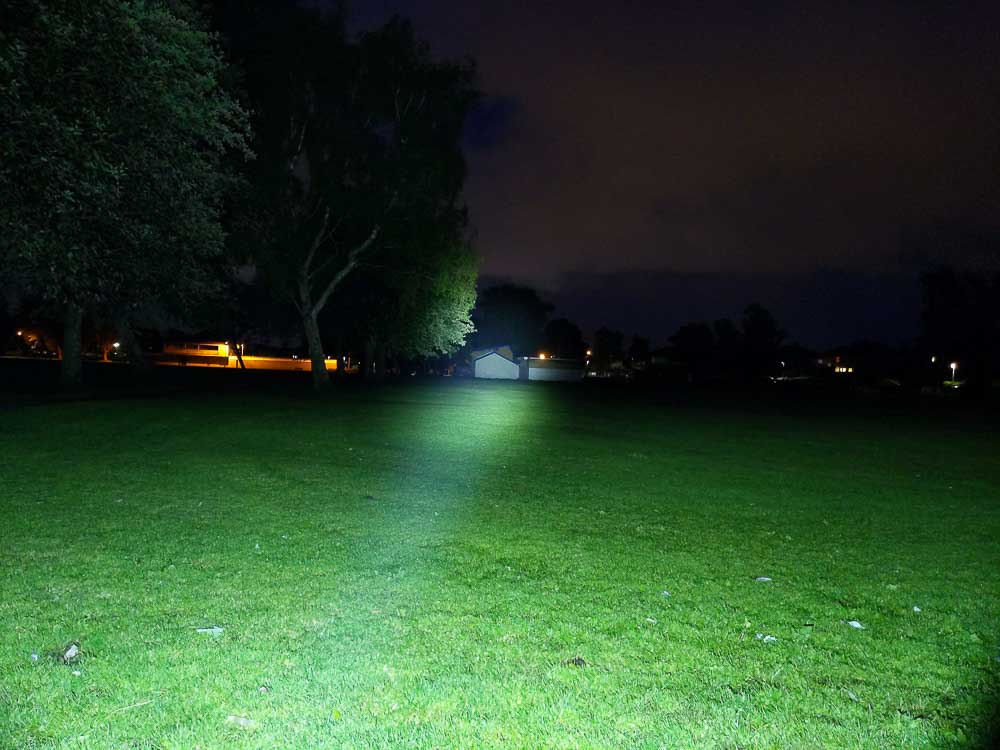
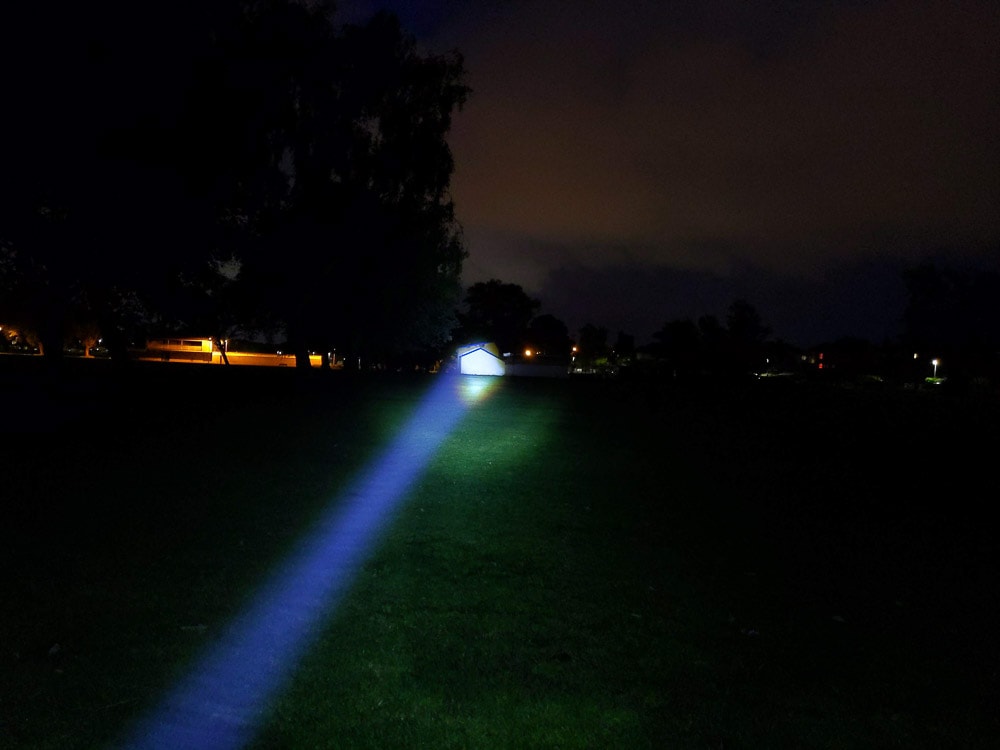
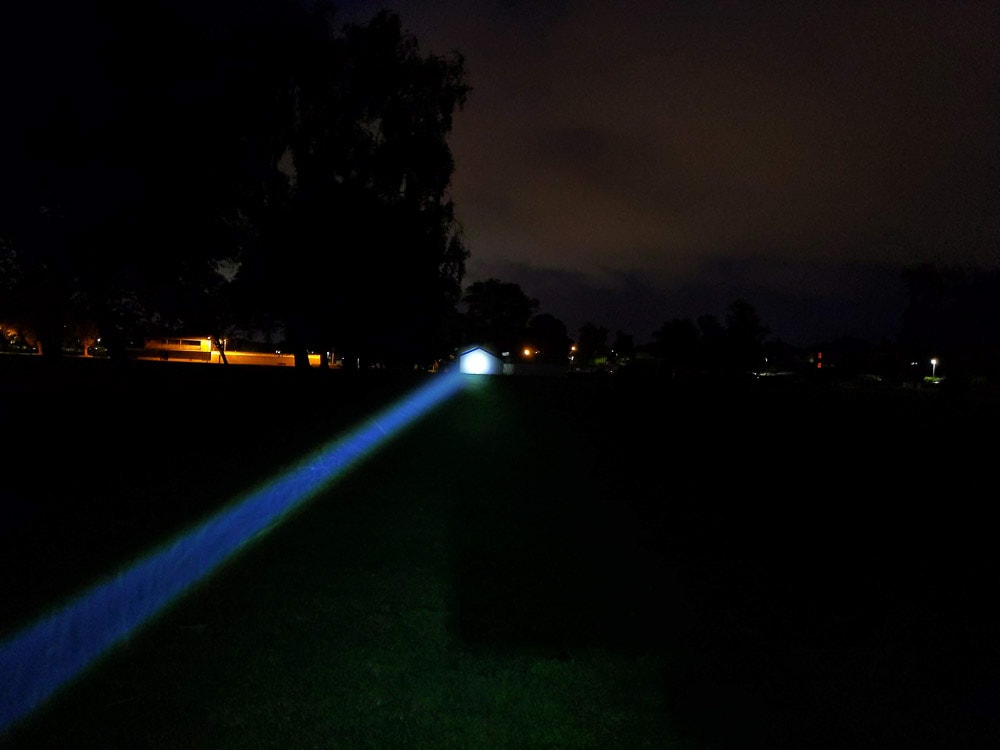
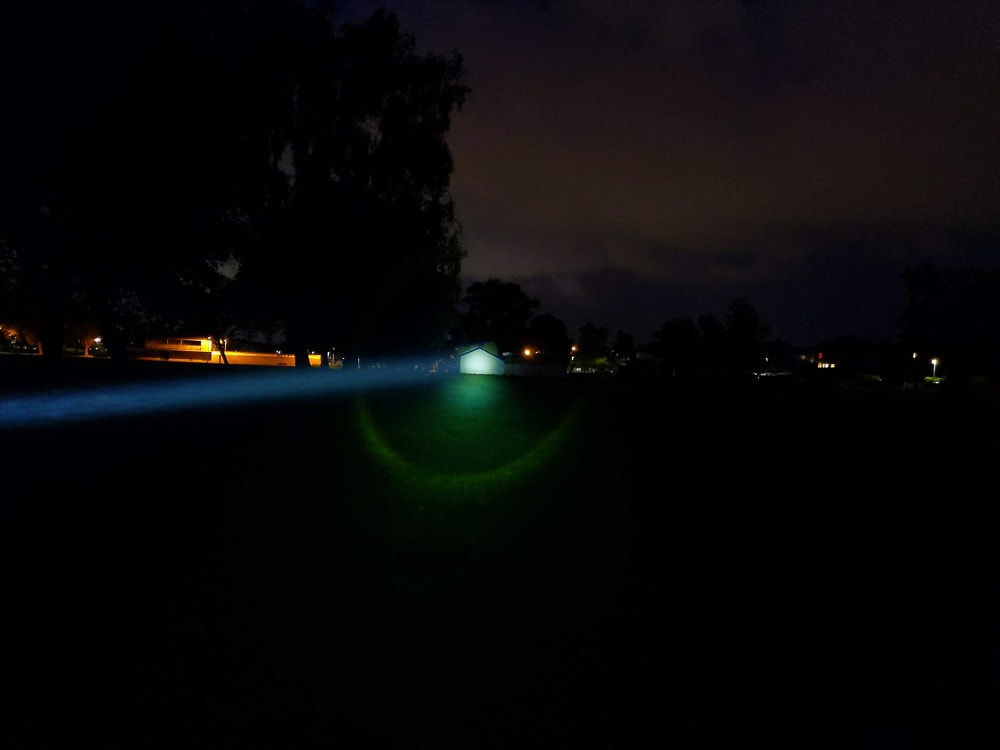
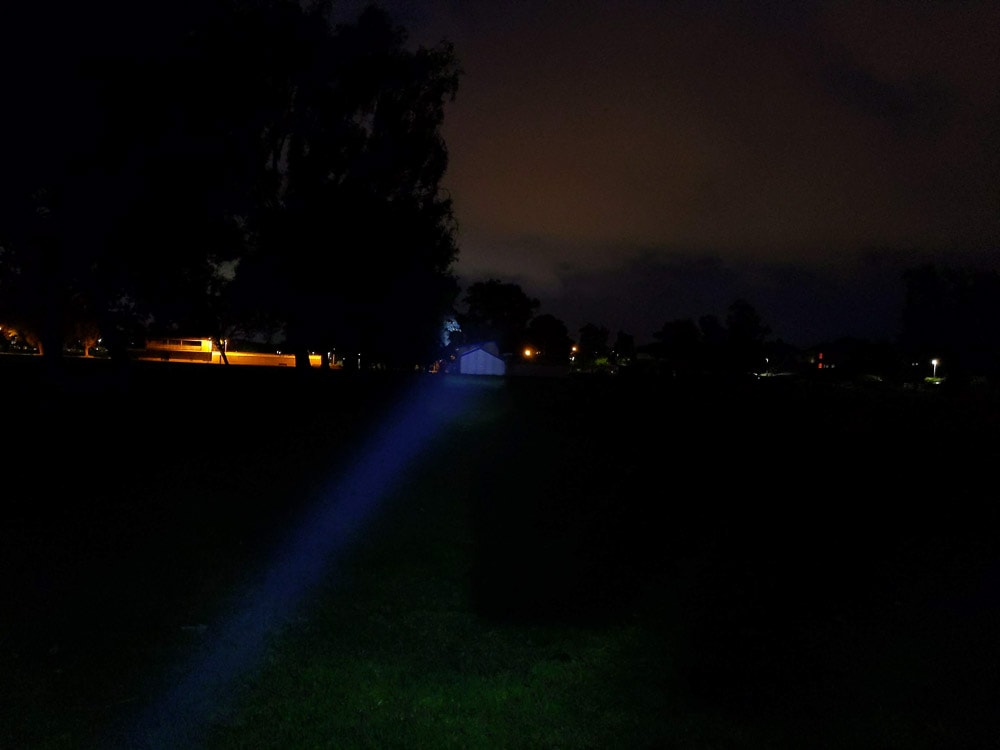
Disclaimer: This flashlight was sent to me for review at no cost by Banggood. I have not been paid to review, nor have I been holding back on problems or defects.
Final Verdict
Pros
- More throw than a similar size LED flashlight
- Cheapest way to get a LEP
- USB-C charging
- Sustains output well
Cons
- No physical or electronic lock out
- Beam pattern isn’t great
Explanation on star ratings:
1: Avoid: my phone flashlight would be a better choice – 2: Poor: significant defect or issues, much better options available at the same price – 3: Average: some defects or issues – 4: Good: recommended (minor issues) – 5: Great: highly recommended

3 stars: ★★★
It throws, it’s cheap, it’s a LEP.
Throwing almost twice as far as LED flashlights with the same bezel size I can’t really complain about this flashlight. For the price and technology, I’m impressed. The quality is reasonable too – it won’t win any awards but I’d expect it to last a while. But it’s certainly not in the same class as other LEPs like the Acebeam W10 in either throw or quality and the beam profile is noticeably bad.
If you’re after the cheapest LEP then this one will out throw any similarly sized LED flashlights. If your budget can reach a bit higher then the Unbranded 26650 LEP has much better performance. It’s also a cheap way to get a LEP module and driver, so might be something that you can put in a larger host.
But if you’re happy with something with a slightly bigger head, then there’s plenty of LED flashlight options: the Convoy M21C throws further at a third of the cost and Acebeam have the L17 and L18. Or if you want zero spill then an aspheric light like the Convoy Z1 throws about as far on turbo. One advantage the RichFire has though is the runtime, as it’s only dropped about 30% after 2 hours.
In summary then: I’d only recommend it if you specifically need (or want) a cheap LEP. There’s much better options around if you’re OK with either spending a bit more on n LEP or getting something a little larger.
Richfire LEP for sale
Unfortunately, the Richfire LEP is no longer for sale at Banggood. Instead, look at the list with the best LEP flashlights.
1lumen selects and reviews products personally. We may earn affiliate commissions through our links, which help support our testing.